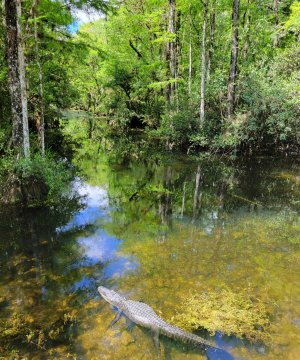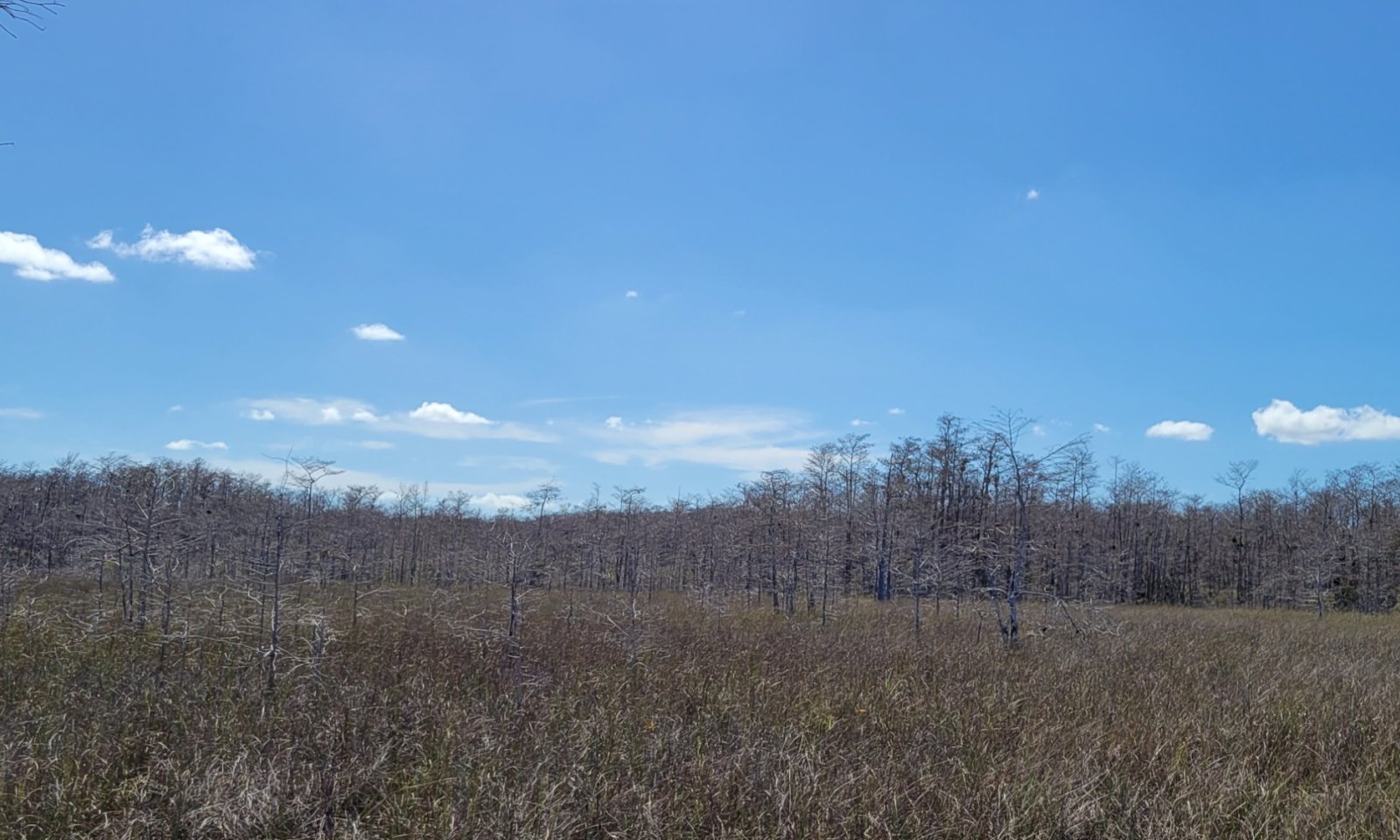
Subtropical Freshwater Cypress Swamps of Big Cypress
Scenario model
Current ecosystem state
Select a state
Management practices/drivers
Select a transition or restoration pathway
-
Transition T1A
Organic Matter Accumulation / Logging of Overstory Cypress
More details -
Transition T1B
Invasion of Non-Native / Exotic Species
More details -
Transition T1C
Decrease in Localized Long Term Hydroperiod and Modify for Desired Land Use
More details -
Transition T1D
Decrease in Localized Long Term Hydroperiod and Human Alteration / Transportation of Soil Materials
More details -
Transition T2A
Cypress Regeneration / Light Surface Fire
More details -
Transition T2B
Invasion of Non-Native / Exotic Species
More details -
Transition T2C
Decrease in Localized Long Term Hydroperiod and Modify for Desired Land Use
More details -
Transition T2D
Decrease in Localized Long Term Hydroperiod and Human Alteration / Transportation of Soil Materials
More details -
Restoration pathway R3A
Mechanical / Biological / Chemical Removal of Species
More details -
Restoration pathway R3B
Mechanical / Biological / Chemical Removal of Species
More details -
Restoration pathway R3C
Mechanical / Biological / Chemical Removal of Undesirable Species
More details -
Transition T3A
Decrease in Localized Long Term Hydroperiod and Human Alteration / Transportation of Soil Materials
More details -
Restoration pathway R4A
Landscape and Habitat Restoration
More details -
Restoration pathway R4B
Landscape and Habitat Restoration
More details -
Transition T4A
Invasion of Non-Native / Exotic Species
More details -
Transition T4B
Decrease in Localized Long Term Hydroperiod and Human Alteration / Transportation of Soil Materials
More details -
No transition or restoration pathway between the selected states has been described
Target ecosystem state
Select a state
State 1
Cypress Swamps
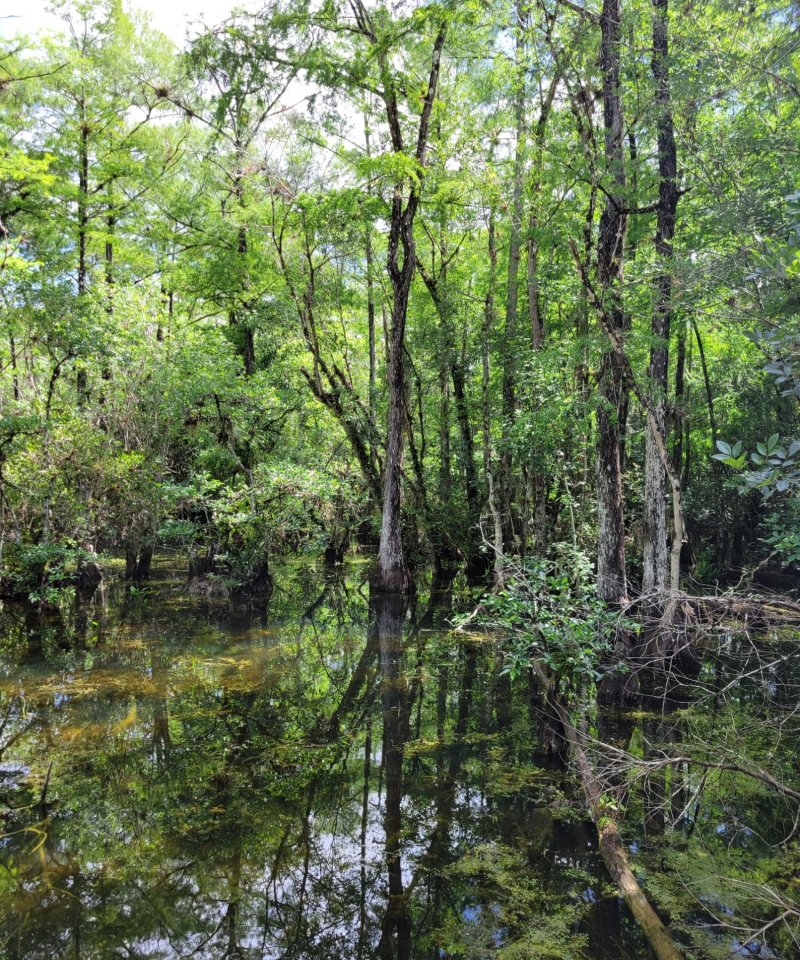

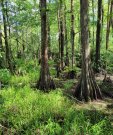
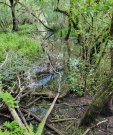
Description
The natural (native) vegetation of this state is mainly dominated by Bald Cypress and Pond Cypress (Taxodium distichum and T. ascendens, respectfully). Occasional fire contributes to the maintenance of a cypress dominated community; without fire, hardwood invasion and peat accumulation create a mixed hardwood and cypress swamp, and under certain conditions the strand may convert to a hardwood forest. In the center of the swamp, there may be open marshes or deeper sloughs. Cypress Swamps have small young trees towards their outer edges, grading into larger and older stands towards the interior, giving the community a distinctively rounded cross -section profile. This site occurs when organic soils accumulate in depressions that are inundated for much of the year, particularly during summer months when litter decomposition rates are high. These organic soils create a unique environment that increases species diversity and structural development in South Florida wetland communities.
Characteristics and indicators
This state is characterized by nearly pure stands of cypress trees (Taxodium spp.) that are distinguished by buttressed trunks. They have smaller, younger trees along the periphery of the swamps, grading into larger and older trees in the center. This gives the community a distinctively rounded cross-section profile.
Resilience management
This state is maintained by both stressors from water and fire. Hydroperiods range from 200 to 300 days per year which only allow flooding tolerant species to survive. Drainage of this site can allow for the invasion of non-native and exotic species and transition the site to a more mesic hardwood community. Fire is another major stressor in this state, with interior swamps burning at long time periods up to every 100 to 150 years, and the edges every 3 to 5 years. The stress from fire prevents the accumulation of organic matter and transition into a hardwood community.
Submodel
Description
Hardwood swamps are dominated by a mix of hydrophytic hardwood trees including bays and cabbage palms. This state occurs on low, wet sites and has short hydroperiods that are inundated seldom over 60 days per year, but are maintained on a consistently saturated peat substrate. These communities form within the Big Cypress region when fire is excluded from cypress swamps for an extended period, allowing organic matter accumulation to create shallower depressions in the landscape, shortening the hydroperiod. With greater accumulation of organic matter and a shortened hydroperiod, hardwood vegetation can become established and, over time, shade out the existing vegetation. Shading from the newly established hardwood species will perpetuate organic matter accumulation and moist soil conditions, favoring this state, continuing the expansion of these communities.
Characteristics and indicators
Hardwood swamps are characterized by hardwood hydrophytic species such as bays and cabbage palms as well as cypress. They are constantly saturated but only inundated for about 60 days per year during the wet season of the summer months (June- October).
Resilience management
The main influencing factors in this state consist of infrequent to occasional fires and long term hydroperiods. Human alterations to surrounding communities can inadvertently drain these sites, making them susceptible to catastrophic fires, in which the organic matter accumulation will be lost, reverting the community back to cypress swamp vegetation or to shrub thickets, depending on the root damage from the fire. Increases in long term hydroperiods will shift the community back towards a cypress swamp as the hardwood species can tolerate some flooding but not the same amount as cypress. Drainage will allow for invasive species to become established that can outcompete the native vegetation.
Submodel
Description
This state consists of Florida Department of Agriculture and Consumer Services (FDACS) Non-Native Category 1 Species list . More information on these species list can be found:
https://www.fdacs.gov/content/download/63140/file/Florida%E2%80%99s_Pest_Plants.pdf
or by contacting the UF / IFAS Center for Aquatic and Invasive Plants (http://plants.ifas.ufl.edu/),
the UF / IFAS Assessment of Non-native Plants in Florida's Natural Areas (https://assessment.ifas.ufl.edu/),
or the FWC Invasive Plant Management Section (http://myfwc.com/wildlifehabitats/invasive-plants/).
This community will not represent every possibility of invasive species but rather the most common in these areas.
Characteristics and indicators
Non-Native species include species that exist outside of Florida's natural range and are introduced to the state via people, weather events, or any other means.
Resilience management
This state can be found as a part of any other state or community and can completely destroy the native habitat if not properly managed. Restoration to natural communities after exotic invasion include practices such as mechanical and chemical removal.
Description
The following communities comprise the major land uses in the United States and the land uses receiving the majority of the conservation treatment that address soil, water, air, plant, and animal resources within the USDA.
Characteristics and indicators
These land uses consist of areas that are not completely naturalized (i.e. native habitat) but are not completely altered by anthropogenic means.
Submodel
States 2 and 5 (additional transitions)
4.2. Open Transitional Managed Communities
4.5. Silviculture
Description
These areas include soils that were intentionally and substantially modified by humans for an intended purpose, commonly for terraced agriculture, building support, mining, transportation, and commerce. The alteration is of sufficient magnitude to result in the introduction of a new parent material (human-transported material) or a profound change in the previously existing parent material (human-altered material). They do not include soils modified through standard agricultural practices or formed soils with unintended wind and water erosion. When a soil is on or above an anthropogenic landform or microfeature, it can be definitely associated with human activity and is assigned to a unique taxa, usually found as an "Urban land complex" within that communities' natural soil properties (e.g., Immokalee sand-Urban land complex, 0 to 2 percent slopes).
Resilience management
Evidence of these areas include soils with manufactured items (e.g. artifacts) present in the profile, human altered-materials (e.g., deeply excavated or deeply plowed soil) or human-transported material (e.g., fill), and position on or above anthropogenic landforms (e.g., flood-control levees) and microfeatures (e.g., drainage ditches). Detailed criteria regarding the identification of anthropogenic (artificial) landforms, human-altered materials, and human-transported material are in the "Keys to Soil Taxonomy" (Soil Survey Staff, 2014).
Submodel
Mechanism
Cypress swamps are dependent on light surface fires as well as long hydroperiods to help maintain community structure and composition. These fires should be allowed to burn naturally within the swamp and be extinguished along natural breaks. In areas where fire has been removed for long periods of time accumulation of organic matter can accumulate and raise the ground surface to allow for the growth of hardwood species.
This transition is also driven by logging, where the cut stumps of cypress may coppice readily. During the period of cypress regrowth other hydrophytic hardwood species may become established in the canopy, and form a mixed hardwood cypress swamp when the cypress return to maturity.
Constraints to recovery
Growth of hardwood species can cause a positive feedback loop in which the ground layer becomes shaded and remains moist for longer periods, excluding fire from the system and allowing for the accumulation of organic matter which can raise the ground surface over time.
Context dependence
This is a long transitional process if occurring naturally, as cypress swamps have fire return intervals ranging from 3 to 5 years along the periphery to over 150 years towards the center of the swamp. Cypress swamps that have bay species in the sub canopy are close to this transition.
Much of the cypress swamps in the Big Cypress eco region were logged during the mid-20th century, during the second World War. Many of the old growth cypress trees were sought due to their decay resistant properties for the development of housing during and after the war.
Mechanism
The invasion of non-native or exotic species can be driven by a multitude of different environmental factors such as changes in natural hydroperiods or in fire regimes. Typically once a change in one of the two factors mentioned above occurs, non-native or exotic invasive species become established and begin to compete with native species for habitat and nutrients.
Constraints to recovery
Recovery from non-native or exotic invasive species may be difficult due to many adaptations which allow them to outcompete and survive in altered conditions. Localized knowledge for each species must be known for best removal of it without harming the native environment, and often different treatments must be applied over one given area.
Context dependence
Growth of non-native and exotic invasive species can be rapid following a change in a natural stressor such as fire frequency or natural hydroperiods which might have once kept the invasive species at bay.
Mechanism
This transition is driven by the decrease in localized long term hydroperiods and modifying the land for the desired land use. This may include the establishment of grazing species or the modification of land for the cultivation of crops of other desired products.
Mechanism
This transition is driven by the decrease in localized long term hydroperiod and the alteration and/ or transportation of soils materials via anthropogenic means.
Mechanism
Transition from mixed hardwood dominated swamps to cypress swamps is mainly influenced by hydroperiods, climate, and fire. Fire must be reestablished within the system to slightly lower the ground level, increasing the hydroperiod and slowly weakening and eventually killing the hardwood species. Available space allows cypress to regenerate with tolerable hydroperiod and fire conditions.
Constraints to recovery
Fire must be reestablished into the system and is dependent on climatic variables as well influences from surrounding pyrogenic communities.
Context dependence
Cypress species are tolerant of light surface fires, helping maintain species composition, but hardwoods and upland conifers are not. These species are killed by surface fires by not only slightly lowering the ground level and increasing the hydroperiods, but through their root systems. The high water tables in cypress swamps forces these species to maintain shallow root systems, which would be weaken and eventually kill these species.
Mechanism
The invasion of non-native or exotic species can be driven by a multitude of different environmental factors such as changes in natural hydroperiods or in fire regimes. Typically once a change in one of the two factors mentioned above occurs, non-native or exotic invasive species become established and begin to compete with native species for habitat and nutrients.
Constraints to recovery
Recovery from non-native or exotic invasive species may be difficult due to many adaptations which allow them to survive and outcompete in intolerable conditions. Localized knowledge for each species must be known for best removal of it without harming the native environment, and often different treatments must be applied over one given area.
Context dependence
Growth of non-native and exotic invasive species can be rapid following a change in a natural stressor such as fire frequency or natural hydroperiods which might have once kept the invasive species at bay.
Mechanism
This transition is driven by the decrease in localized long term hydroperiods and modifying the land for the desired land use. This may include the establishment of grazing species or the modification of land for the cultivation of crops of other desired products.
Mechanism
This transition is driven by the decrease in localized long term hydroperiod and the alteration and/ or transportation of soils materials via anthropogenic means.
Mechanism
Mechanical, biological, and chemical removal strategies include removing the non-native and exotic invasive species through various mechanisms. Localized knowledge for individual non-native or exotic invasive species is needed for specific management. Sometimes introduction of fire regimes may prevent or stop the growth of non-native or exotic invasive species, but many species are fire tolerant. Mechanical removal might include roller chopping, harvesting, or cutting and removal of invasive species. Chemical removal might include aerial dispersal from planes, or basal bark injection treatments.
Context dependence
Mechanical, biological, and chemical removal of non-native and exotic invasive species is a time dependent process, with both removal types taking long times to be considered effective.
Mechanism
Mechanical, biological, and chemical removal strategies include removing the non-native and exotic invasive species through various mechanisms. Localized knowledge for individual non-native or exotic invasive species is needed for specific management. Sometimes introduction of fire regimes may prevent or stop the growth of non-native or exotic invasive species, but many species are fire tolerant. Mechanical removal might include roller chopping, harvesting, or cutting and removal of invasive species. Chemical removal might include aerial dispersal from planes, or basal bark injection treatments.
Context dependence
Mechanical, biological, and chemical removal of non-native and exotic invasive species is a time dependent process, with both removal types taking long times to be considered effective.
Mechanism
Mechanical, biological, and chemical removal strategies include removing the non-native and exotic invasive species through various mechanisms. Localized knowledge for individual non-native or exotic invasive species is needed for specific management. Sometimes introduction of fire regimes may prevent or stop the growth of non-native or exotic invasive species, but many species are fire tolerant. Mechanical removal might include roller chopping, harvesting, or cutting and removal of invasive species. Chemical removal might include aerial dispersal from planes, or basal bark injection treatments.
Context dependence
Mechanical, biological, and chemical removal of non-native and exotic invasive species is a time dependent process, with both removal types taking long times to be considered effective.
Mechanism
This transition is driven by the decrease in localized long term hydroperiod and the alteration and/ or transportation of soils materials via anthropogenic means.
Mechanism
These practices include the restoration of both the natural hydroperiod and landscape in advance of revegetating the area (if needed).
Mechanism
These practices include the restoration of both the natural hydroperiod and landscape in advance of revegetating the area (if needed).
Mechanism
The invasion of non-native or exotic species can be driven by a multitude of different environmental factors such as changes in natural hydroperiods or in fire regimes. Typically once a change in one of the two factors mentioned above occurs, non-native or exotic invasive species become established and begin to compete with native species for habitat and nutrients.
Context dependence
Recovery from non-native or exotic invasive species may be difficult due to many adaptations which allow them to outcompete and survive in intolerable conditions. Localized knowledge for each species must be known for best management of it it without harming the natural habitat, and often different treatments must be applied over one given area.
Growth of non-native and exotic invasive species can be rapid following a change in a natural stressor such as fire frequency or natural hydroperiods which might have once kept the invasive species at bay.
Model keys
Briefcase
Add ecological sites and Major Land Resource Areas to your briefcase by clicking on the briefcase (![]() ) icon wherever it occurs. Drag and drop items to reorder. Cookies are used to store briefcase items between browsing sessions. Because of this, the number of items that can be added to your briefcase is limited, and briefcase items added on one device and browser cannot be accessed from another device or browser. Users who do not wish to place cookies on their devices should not use the briefcase tool. Briefcase cookies serve no other purpose than described here and are deleted whenever browsing history is cleared.
) icon wherever it occurs. Drag and drop items to reorder. Cookies are used to store briefcase items between browsing sessions. Because of this, the number of items that can be added to your briefcase is limited, and briefcase items added on one device and browser cannot be accessed from another device or browser. Users who do not wish to place cookies on their devices should not use the briefcase tool. Briefcase cookies serve no other purpose than described here and are deleted whenever browsing history is cleared.
Ecological sites
Major Land Resource Areas
The Ecosystem Dynamics Interpretive Tool is an information system framework developed by the USDA-ARS Jornada Experimental Range, USDA Natural Resources Conservation Service, and New Mexico State University.

